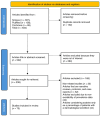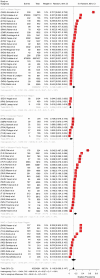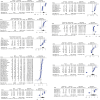Prevalence and determinants of scabies: A global systematic review and meta-analysis
- PMID: 39575757
- PMCID: PMC11613430
- DOI: 10.1111/tmi.14058
Prevalence and determinants of scabies: A global systematic review and meta-analysis
Abstract
Objectives: Scabies is a neglected skin disease that disproportionately affects people from resource poor and overcrowded countries. Global data on prevalence and risk factors are limited. This article aims to estimate the global burden of scabies and identifies the risks associated with it.
Methods: Databases (PubMed, Scopus and Cochrane Reviews) were accessed to identify studies of scabies prevalence published between 2000 and 2024. Results were pooled to estimate prevalence and identify factors, which explained between-study heterogeneity. Odds ratios (ORs), risk of bias, subgroup analyses and meta-regression were used to describe variation in effect size and heterogeneity based on country-level demographic and economic variables.
Results: Seventy studies yielded a pooled prevalence of 11.9% (95% confidence interval [CI]: 9.60-14.7) with substantial heterogeneity . Prevalence was highest in Oceania (17.9%; 95% CI: 13.9-22.8) compared to other regions. Pooled risk factors for scabies showed significant associations for demographic and behavioural factors including contact history with household members with itch (OR 11.3; 95% CI 4.82-26.51; ; n = 7), lack of soap use (OR 3.41; 95% CI: 2.56-4.54; ; n = 7), bed-sharing (OR 2.64; 95% CI: 1.50-4.63; ; n = 7), sharing of clothes (OR 2.52; 95% CI: 1.58-4.03; ; n = 7), infrequent bathing (OR 2.13; 95% CI: 1.41-3.22; ; n = 6), presence of pets (OR 1.76; 95% CI: 1.08-2.87; ; n = 4) and being a male (OR = 1.19; 95% CI: 1.04-1.37; ; n = 22). Socioeconomic factors were not convincingly associated with scabies prevalence.
Conclusion: Prevalence of scabies is associated with geographic location and behavioural factors, but not between-country socioeconomic status. In addition to mass drug administration, risk factors are identified which may be included in health promotion programmes to reduce scabies prevalence and its sequelae in the long term.
Keywords: mass‐drug administration; prevalence; risk factors; scabies.
© 2024 The Author(s). Tropical Medicine & International Health published by John Wiley & Sons Ltd.
Conflict of interest statement
The authors declare no conflicts of interest.
Figures




Similar articles
-
Physical interventions to interrupt or reduce the spread of respiratory viruses.Cochrane Database Syst Rev. 2023 Jan 30;1(1):CD006207. doi: 10.1002/14651858.CD006207.pub6. Cochrane Database Syst Rev. 2023. PMID: 36715243 Free PMC article.
-
Electronic cigarettes for smoking cessation.Cochrane Database Syst Rev. 2021 Sep 14;9(9):CD010216. doi: 10.1002/14651858.CD010216.pub6. Cochrane Database Syst Rev. 2021. Update in: Cochrane Database Syst Rev. 2022 Nov 17;11:CD010216. doi: 10.1002/14651858.CD010216.pub7. PMID: 34519354 Free PMC article. Updated.
-
Electronic cigarettes for smoking cessation.Cochrane Database Syst Rev. 2022 Nov 17;11(11):CD010216. doi: 10.1002/14651858.CD010216.pub7. Cochrane Database Syst Rev. 2022. Update in: Cochrane Database Syst Rev. 2024 Jan 8;1:CD010216. doi: 10.1002/14651858.CD010216.pub8. PMID: 36384212 Free PMC article. Updated.
-
Interventions to prevent surgical site infection in adults undergoing cardiac surgery.Cochrane Database Syst Rev. 2024 Dec 2;12(12):CD013332. doi: 10.1002/14651858.CD013332.pub2. Cochrane Database Syst Rev. 2024. PMID: 39620424
-
Heated tobacco products for smoking cessation and reducing smoking prevalence.Cochrane Database Syst Rev. 2022 Jan 6;1(1):CD013790. doi: 10.1002/14651858.CD013790.pub2. Cochrane Database Syst Rev. 2022. PMID: 34988969 Free PMC article.
Cited by
-
Burden and determinants of scabies in Ethiopian school age children: A systematic review and meta-analysis with public health implications.PLoS One. 2024 Dec 19;19(12):e0314882. doi: 10.1371/journal.pone.0314882. eCollection 2024. PLoS One. 2024. PMID: 39700220 Free PMC article.
-
Environmental and Social Factors Associated with the Occurrence of Severe Tungiasis and Scabies in the State of Ceará, Brazil: An Ecological Study.Trop Med Infect Dis. 2025 May 16;10(5):135. doi: 10.3390/tropicalmed10050135. Trop Med Infect Dis. 2025. PMID: 40423364 Free PMC article.
-
Risk Factors and Lesion Patterns in Treatment-Resistant Scabies: Impact of Sex, Age, and Comorbidities.Acta Parasitol. 2025 May 27;70(3):116. doi: 10.1007/s11686-025-01055-6. Acta Parasitol. 2025. PMID: 40423844 Free PMC article.
-
Effect of ivermectin on scabies: a retrospective evaluation.BMC Infect Dis. 2025 Jul 23;25(1):937. doi: 10.1186/s12879-025-11315-5. BMC Infect Dis. 2025. PMID: 40702460 Free PMC article.
-
Status of the scabies outbreak before, during and after the Covid- 19 pandemic: a single-center hospital-based retrospective evaluation.BMC Infect Dis. 2025 Apr 8;25(1):481. doi: 10.1186/s12879-025-10922-6. BMC Infect Dis. 2025. PMID: 40200153 Free PMC article.
References
Publication types
MeSH terms
Grants and funding
LinkOut - more resources
Full Text Sources
Medical
Research Materials

